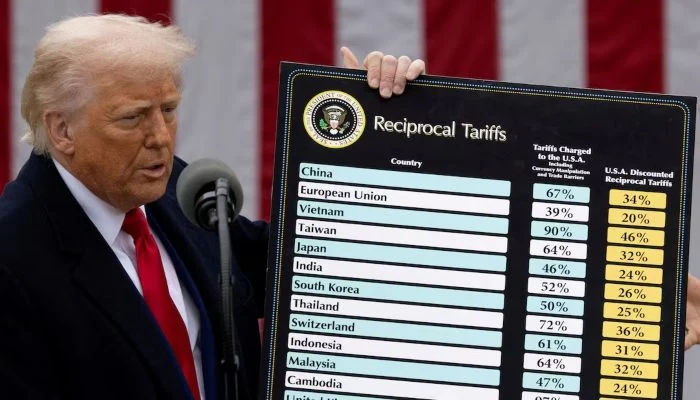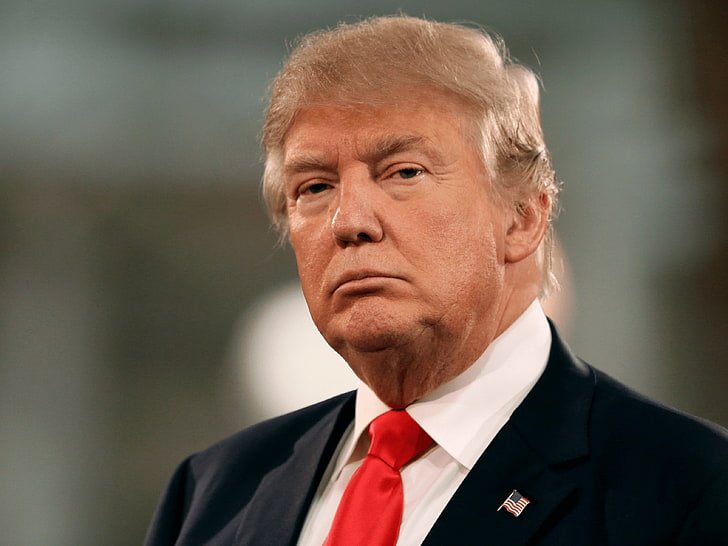Trump Imposes 19% Tariff on Indonesia, Signals More Tariff Letters for Smaller Nations
By Reuters | Updated July 16, 2025
In a major escalation of his ongoing tariff campaign, U.S. President Donald Trump announced on Tuesday that a 19% tariff would be imposed on imports from Indonesia, marking a new trade agreement between the two countries. Trump also revealed that similar tariff notifications for dozens of smaller countries were being prepared and would be released in the coming days.
The announcement, made from the Rose Garden at the White House, reflects Trump’s continued commitment to reshaping U.S. trade policy through aggressive measures that he says will reduce the American trade deficit and bring manufacturing jobs back to the U.S.
Indonesia Trade Deal: A New Tariff Pact
While Indonesia is not among the top 15 trading partners of the United States, the agreement is significant because it adds to a growing list of smaller countries that are now facing steeper tariffs under Trump’s evolving trade strategy. According to the U.S. Census Bureau, bilateral trade between the U.S. and Indonesia stood at nearly $40 billion in 2024, with the U.S. running a trade deficit of approximately $18 billion.
The new deal includes:
-
A flat 19% tariff on Indonesian goods exported to the United States.
-
Zero tariffs on U.S. exports to Indonesia.
-
Penalty clauses for transhipments from China via Indonesia.
-
A commitment by Indonesia to purchase billions of dollars’ worth of U.S. products.
Speaking to reporters, Trump stated,
“They are going to pay 19% and we are going to pay nothing. We will have full access into Indonesia. And we have a couple of those deals that are going to be announced.”
$15 Billion in U.S. Energy and 50 Boeing Jets
Shortly after the public announcement, Trump took to his Truth Social platform to share additional details, claiming Indonesia had agreed to:
-
Buy $15 billion worth of U.S. energy products.
-
Purchase $4.5 billion in American agricultural products.
-
Order 50 Boeing aircraft — although no timeline was provided.
Officials in Jakarta confirmed that discussions were underway and a joint statement would be issued soon to provide further clarity.
Indonesia Responds
Susiwijono Moegiarso, a senior official from Indonesia’s Coordinating Ministry for Economic Affairs, told Reuters via text message that both sides were finalizing the terms.
“We are preparing a joint statement… including the tariff deal, non-tariff aspects, and commercial arrangements. We will inform the public soon.”
Interestingly, just last week, Trump had threatened to impose a 32% tariff on Indonesia starting August 1 if no deal was reached — a threat delivered in an official letter to the Indonesian president. Similar warning letters have also been sent this month to over two dozen countries, including Canada, Japan, and Brazil, laying out tariff increases ranging from 20% to 50%, and in some cases, even a 50% tariff on copper.
Trump’s Trade Strategy: Simpler, Broader, Tougher
Speaking in Pittsburgh earlier Tuesday, Trump emphasized that he preferred blanket tariffs over complicated trade negotiations. Despite that stance, his Treasury Secretary Scott Bessent and Commerce Secretary Howard Lutnick are actively working on negotiating more agreements before the looming August 1 deadline, when tariffs on most U.S. imports are set to increase.
Letters Coming for Smaller Nations
Upon his return to Washington, Trump confirmed that new letters were being finalized for many smaller countries, signaling that they too would soon face tariffs “a little over 10%” unless favorable trade terms were established.
The U.S. administration’s aggressive approach has unsettled many governments and investors worldwide. Critics say Trump’s strategy is destabilizing global markets, while supporters argue it’s the kind of tough action long overdue to protect American jobs.
Tariffs on Pharmaceuticals Coming Soon
In addition to the Indonesia agreement, Trump revealed that his administration would soon impose tariffs on imported pharmaceuticals, a move that would initially begin with a low rate to allow companies time to relocate production to the United States. Over time, these tariffs would rise significantly.
“We’re starting low so they have time to bring manufacturing back here,” Trump explained. “Then we hit them with a very high tariff after a year or so.”
Economists are closely watching the pharmaceutical move, noting that the sector is sensitive and strategic, with heavy reliance on overseas production.
Highest Tariff Rates Since 1933
According to recent estimates by Yale Budget Lab, based on Trump’s public tariff announcements through Sunday, the average effective U.S. tariff rate is expected to rise to 20.6%, a significant jump from the pre-Trump level of 2–3%.
Even accounting for shifts in consumer behavior — such as purchasing fewer foreign goods — the adjusted tariff rate is expected to land at 19.7%, which would be the highest since 1933, during the Great Depression.
Trump’s Tariff Deals So Far: Limited Progress
Despite Trump’s tough rhetoric and ambitious goal of signing “90 deals in 90 days,” only a handful of agreements have been reached:
-
Vietnam: A preliminary trade deal similar to Indonesia’s has been announced, with a flat tariff on Vietnamese goods and no levies on U.S. exports.
-
United Kingdom: A framework trade agreement was reached earlier this year.
-
China: An interim agreement is in place to delay the steepest tariffs while more detailed negotiations continue.
When asked about Vietnam, Trump said the agreement was “pretty well set” but declined to release any additional specifics.
Talks with India Also Advancing
Trump also mentioned that discussions with India were progressing in a similar fashion and that a future agreement would allow U.S. companies greater access to the Indian market.
“India is moving along that same line,” Trump told reporters confidently.
EU Prepares Retaliation
While Trump continues to finalize deals with smaller nations, tensions are escalating with the European Union, America’s largest trading partner.
The European Commission has circulated a list among member states outlining potential retaliatory tariffs worth 72 billion euros ($84.1 billion). The items targeted include:
-
Boeing aircraft
-
Cars and car parts
-
Medical devices
-
Chemical and electrical equipment
-
Agricultural goods like fruits, wine, beer, and spirits
The EU’s list comes in response to the baseline 10% tariffs already in effect and additional Trump threats to slap a 30% tariff on all EU imports starting August 1.
EU Officials: “Unacceptable Terms”
European officials have stated that Trump’s proposed 30% tariff rate is unacceptable and would effectively end normal trade relations between the U.S. and the EU.
The retaliation package aims to hit American exporters hard — especially in states that are politically important to the upcoming U.S. elections.
Growing Economic Uncertainty
The rising tariffs and looming threats are already rattling global markets and generating concerns about a new wave of inflation in the United States, particularly for consumer goods, cars, electronics, and now even medicines.
Experts say that if supply chains shift rapidly due to high tariffs, consumers could see significant price increases in 2025 and beyond. At the same time, some American industries — particularly energy, aerospace, and agriculture — could benefit from new export commitments made by countries like Indonesia.
Conclusion
President Trump’s imposition of a 19% tariff on Indonesian goods marks a bold new phase in his second-term trade agenda. With tariff letters reportedly going out to dozens of smaller nations, and new levies on pharmaceuticals around the corner, global trade dynamics are shifting fast.
While Trump claims these moves will protect American jobs and industries, critics warn of inflation, supply chain disruptions, and retaliation from major trading partners like the European Union.
With the critical August 1 deadline fast approaching, the next few weeks may determine the shape of global trade for years to come.
____________________________________________________________________________________________________________________________________
No Record of 40,000 Zaireen who Didn’t Return from Iraq, Iran, Syria: Minister
Read This Article
Trump Imposes 19% Tariff on Indonesia, Signals More Tariff Letters for Smaller Nations
By Reuters | Updated July 16, 2025
In a major escalation of his ongoing tariff campaign, U.S. President Donald Trump announced on Tuesday that a 19% tariff would be imposed on imports from Indonesia, marking a new trade agreement between the two countries. Trump also revealed that similar tariff notifications for dozens of smaller countries were being prepared and would be released in the coming days.
The announcement, made from the Rose Garden at the White House, reflects Trump’s continued commitment to reshaping U.S. trade policy through aggressive measures that he says will reduce the American trade deficit and bring manufacturing jobs back to the U.S.
Indonesia Trade Deal: A New Tariff Pact
While Indonesia is not among the top 15 trading partners of the United States, the agreement is significant because it adds to a growing list of smaller countries that are now facing steeper tariffs under Trump’s evolving trade strategy. According to the U.S. Census Bureau, bilateral trade between the U.S. and Indonesia stood at nearly $40 billion in 2024, with the U.S. running a trade deficit of approximately $18 billion.
The new deal includes:
-
A flat 19% tariff on Indonesian goods exported to the United States.
-
Zero tariffs on U.S. exports to Indonesia.
-
Penalty clauses for transhipments from China via Indonesia.
-
A commitment by Indonesia to purchase billions of dollars’ worth of U.S. products.
Speaking to reporters, Trump stated,
“They are going to pay 19% and we are going to pay nothing. We will have full access into Indonesia. And we have a couple of those deals that are going to be announced.”
$15 Billion in U.S. Energy and 50 Boeing Jets
Shortly after the public announcement, Trump took to his Truth Social platform to share additional details, claiming Indonesia had agreed to:
-
Buy $15 billion worth of U.S. energy products.
-
Purchase $4.5 billion in American agricultural products.
-
Order 50 Boeing aircraft — although no timeline was provided.
Officials in Jakarta confirmed that discussions were underway and a joint statement would be issued soon to provide further clarity.
Indonesia Responds
Susiwijono Moegiarso, a senior official from Indonesia’s Coordinating Ministry for Economic Affairs, told Reuters via text message that both sides were finalizing the terms.
“We are preparing a joint statement… including the tariff deal, non-tariff aspects, and commercial arrangements. We will inform the public soon.”
Interestingly, just last week, Trump had threatened to impose a 32% tariff on Indonesia starting August 1 if no deal was reached — a threat delivered in an official letter to the Indonesian president. Similar warning letters have also been sent this month to over two dozen countries, including Canada, Japan, and Brazil, laying out tariff increases ranging from 20% to 50%, and in some cases, even a 50% tariff on copper.
Trump’s Trade Strategy: Simpler, Broader, Tougher
Speaking in Pittsburgh earlier Tuesday, Trump emphasized that he preferred blanket tariffs over complicated trade negotiations. Despite that stance, his Treasury Secretary Scott Bessent and Commerce Secretary Howard Lutnick are actively working on negotiating more agreements before the looming August 1 deadline, when tariffs on most U.S. imports are set to increase.
Letters Coming for Smaller Nations
Upon his return to Washington, Trump confirmed that new letters were being finalized for many smaller countries, signaling that they too would soon face tariffs “a little over 10%” unless favorable trade terms were established.
The U.S. administration’s aggressive approach has unsettled many governments and investors worldwide. Critics say Trump’s strategy is destabilizing global markets, while supporters argue it’s the kind of tough action long overdue to protect American jobs.
Tariffs on Pharmaceuticals Coming Soon
In addition to the Indonesia agreement, Trump revealed that his administration would soon impose tariffs on imported pharmaceuticals, a move that would initially begin with a low rate to allow companies time to relocate production to the United States. Over time, these tariffs would rise significantly.
“We’re starting low so they have time to bring manufacturing back here,” Trump explained. “Then we hit them with a very high tariff after a year or so.”
Economists are closely watching the pharmaceutical move, noting that the sector is sensitive and strategic, with heavy reliance on overseas production.
Highest Tariff Rates Since 1933
According to recent estimates by Yale Budget Lab, based on Trump’s public tariff announcements through Sunday, the average effective U.S. tariff rate is expected to rise to 20.6%, a significant jump from the pre-Trump level of 2–3%.
Even accounting for shifts in consumer behavior — such as purchasing fewer foreign goods — the adjusted tariff rate is expected to land at 19.7%, which would be the highest since 1933, during the Great Depression.
Trump’s Tariff Deals So Far: Limited Progress
Despite Trump’s tough rhetoric and ambitious goal of signing “90 deals in 90 days,” only a handful of agreements have been reached:
-
Vietnam: A preliminary trade deal similar to Indonesia’s has been announced, with a flat tariff on Vietnamese goods and no levies on U.S. exports.
-
United Kingdom: A framework trade agreement was reached earlier this year.
-
China: An interim agreement is in place to delay the steepest tariffs while more detailed negotiations continue.
When asked about Vietnam, Trump said the agreement was “pretty well set” but declined to release any additional specifics.
Talks with India Also Advancing
Trump also mentioned that discussions with India were progressing in a similar fashion and that a future agreement would allow U.S. companies greater access to the Indian market.
“India is moving along that same line,” Trump told reporters confidently.
EU Prepares Retaliation
While Trump continues to finalize deals with smaller nations, tensions are escalating with the European Union, America’s largest trading partner.
The European Commission has circulated a list among member states outlining potential retaliatory tariffs worth 72 billion euros ($84.1 billion). The items targeted include:
-
Boeing aircraft
-
Cars and car parts
-
Medical devices
-
Chemical and electrical equipment
-
Agricultural goods like fruits, wine, beer, and spirits
The EU’s list comes in response to the baseline 10% tariffs already in effect and additional Trump threats to slap a 30% tariff on all EU imports starting August 1.
EU Officials: “Unacceptable Terms”
European officials have stated that Trump’s proposed 30% tariff rate is unacceptable and would effectively end normal trade relations between the U.S. and the EU.
The retaliation package aims to hit American exporters hard — especially in states that are politically important to the upcoming U.S. elections.
Growing Economic Uncertainty
The rising tariffs and looming threats are already rattling global markets and generating concerns about a new wave of inflation in the United States, particularly for consumer goods, cars, electronics, and now even medicines.
Experts say that if supply chains shift rapidly due to high tariffs, consumers could see significant price increases in 2025 and beyond. At the same time, some American industries — particularly energy, aerospace, and agriculture — could benefit from new export commitments made by countries like Indonesia.
Conclusion
President Trump’s imposition of a 19% tariff on Indonesian goods marks a bold new phase in his second-term trade agenda. With tariff letters reportedly going out to dozens of smaller nations, and new levies on pharmaceuticals around the corner, global trade dynamics are shifting fast.
While Trump claims these moves will protect American jobs and industries, critics warn of inflation, supply chain disruptions, and retaliation from major trading partners like the European Union.




